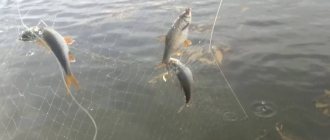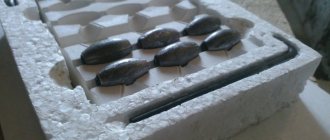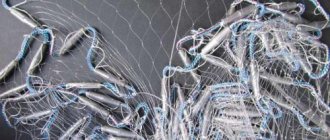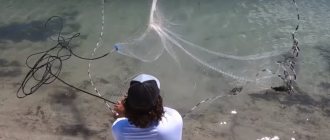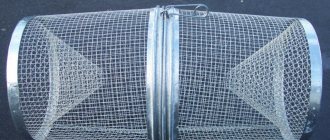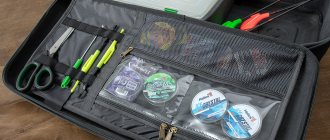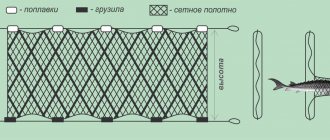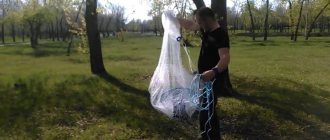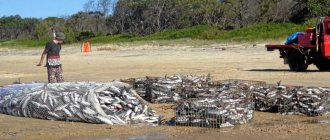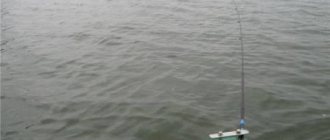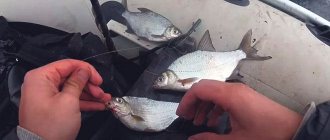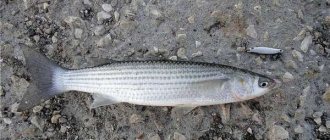How to catch fish on the track?
The presence of fish in a body of water does not guarantee its capture. An error in the layout of gear, the choice of bait, or a change in weather can easily deprive you of your catch. A trail net will help you avoid fruitless fishing trips. However, this tackle should not be confused with spinning fishing on the track, which involves towing an artificial bait or fish on a tackle behind a boat. Track fishing - a net with a rubber shock absorber - can be used independently or together with other fishing methods, which, combined with its simplicity and low price, makes it attractive to fishermen, hunters and tourists.
To ensure that fishing is not fruitless, you must use a net-track
What kind of fish is this tackle suitable for?
Fishing with “track” gear is carried out in the coastal zone and, accordingly, the catch can include almost any fish that comes close to the shore, the size of which corresponds to the size of the net mesh.
The most effective path is when catching crucian carp in ponds and schooling white fish in the current. So in rivers the catch most often includes:
- roach;
- silver bream;
- white bream;
- blue;
- ide.
Read more
How to catch carp in summer?
Quite often, predatory fish - pike, perch, and, late in the evening, pike perch - get caught in the net. It is worth noting that catching pike perch with a line using a tackle is much more effective, but has nothing to do with fishing with net tackle, as already mentioned above.
Unlikely to be caught:
- bottom fish, for example, gudgeon, goby;
- inhabitants of open spaces - asp, saberfish;
- large specimens of carp, silver carp, grass carp, pike, catfish, etc., capable of breaking the net.
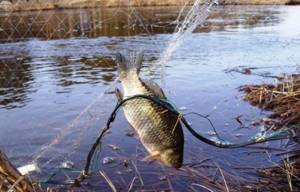
Crucian carp, as well as predatory fish, quite often become prisoners of the net
What is a fishing line tackle?
A track is a fishing tackle that is similar to a donkey with a rubber shock absorber in terms of the method of installation and removal from the water. It is a piece of net fabric made of fishing line, equipped with weights and floats. The canvas size is usually 5-10 m in length and about 1.5 m in height. The cell size is from 18 to 80 mm, depending on the expected catch.
The assembled tackle includes:
- the network itself, described above;
- rubber shock absorber;
- a sinker that holds the tackle in place;
- cord or thick fishing line for removing the net from the water.
Sometimes the track is supplemented with a signaling bell, and the sinker in shallow water is replaced with a pole driven into the bottom.
In recent years, the track net has become widespread, in contrast to such exotic, in our places, gear as a casting net. This is largely due to the similarity in use with the “elastic band”, which is well known to our fishermen. However, it is necessary to take into account that if fishing with an elastic band is recognized by the rules of amateur fishing, then fishing with a line in most reservoirs is considered poaching.
Anglers often call this type of fishing line fishing with an elastic band, or simply “with an elastic band,” which causes some confusion in terms, since when they say “with an elastic band,” they usually mean a donkey with a rubber shock absorber.
Tactics and techniques for fishing with different types of fish
Any fishing begins with choosing a suitable place. Fishing with "track" nets can be carried out in ponds and lakes, as well as in rivers with moderate currents. The path is not suitable for use in strong currents, as it will not only be carried away, but also clogged with floating debris.
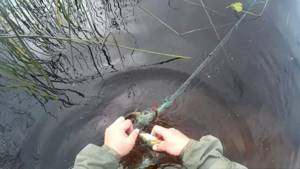
For the track network, you need to find a suitable place free of snags
It is important that the fishing area has moderate depth and a bottom free of snags. It is also important to have a place on the shore free from tall grass, bushes and reeds for manipulating the net removed from the water.
And, of course, the most important factor in choosing a place is the presence of fish to be caught. The most promising are shallows near pits, deep riffles of small rivers, boundaries of aquatic vegetation and clean water.
Read more
What to feed bream during winter fishing?
The fishing technique includes installing (casting) the tackle, noticing when the fish gets into the net and retrieving the catch:
- casting of the tackle is carried out without a net, which is attached to the tackle after the sinker is fixed at the bottom;
- so that the unraveling of the fishing line when fishing on the path occurs without problems, it is carefully laid in rings on the shore;
- the presence of fish caught in the net can be determined by vibrations of the gear or an alarm;
- When retrieving caught fish, it is important not to damage the net, because each break point leads to a decrease in the effectiveness of the gear and a shortening of its service life.
In the vast majority of cases, fishing on the track is carried out from the shore, and a boat can be used to bring in cargo. But, nevertheless, fishing on the path from a boat is also possible. It is justified when it is necessary to install a network along the coastline. An important point is to securely fix the boat on two anchors to prevent movement of the gear caused by the movement of the boat.
Catching a certain type of fish for fishing is carried out by selecting the appropriate mesh size and the bait used. It should be borne in mind that the track, like other net gear, is a non-selective method of fishing.
"Track"
This recently appeared tackle has nothing to do with fishing with spoons from a boat floating under oars, sail or motor - a coincidence of names, nothing more. It would be more correct to call it a “network with a rubber shock absorber”; small “paths” – “screens with rubber shock absorbers”.
The general diagram of the “track” is shown in Fig. 12, and fishing with it is not much different from fishing with a donkey with a shock absorber: the fisherman throws a heavy load with a rubber thread tied to it into the reservoir, and then, as it contracts, inserts a small fixed net into the reservoir, planted on the cargo and floating cords.
The net itself usually does not participate in casting: the fishing line and elastic band are connected using two metal carabiners, and after casting, the carbines are disconnected and attached to loops made at the ends of the floating cord. The weight of the carabiners is compensated by two large foam floats, which also help ensure that the residual tension of the elastic does not prevent the net from standing in the water in a regular rectangle.
The mesh pitch depends on the size of the expected prey. The height of the net rarely exceeds 1.5 m, and the length (when casting from the shore) is 7 m.
Rice. 12. Fishing on the “track”: 1 – pole; 2 – signaling bell; 3 – fishing line (diameter 1–1.2 mm, length up to 30 m); 4 – load cord; 5 – floating cord; 6 – net (up to 7 m in landing); 7 – weight (weight is determined by the thickness of the rubber shock absorber)
There is another, simplified “track” design. In it, both the cargo and floating cords are replaced with thick nylon thread. The net is stretched into a rectangular shape horizontally by the tension of the elastic band and fishing line, and vertically by thin, strong slats tied on the sides in the manner of nags on a seine (the lower ends of the slats are weighted with lead weights, providing slight negative buoyancy).
Tackle assembled according to the second option provides significantly less resistance when the shock absorber pulls it into the reservoir, which allows the use of longer nets - up to 15–20 m. However, it can only be used in standing reservoirs; even a weak current bends the slats and lays them on bottom. Therefore, such a “path” is most often used for pond fishing for crucian carp.
Fishing places
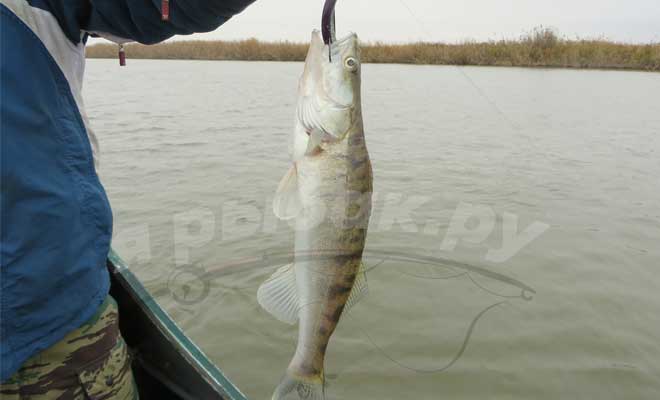
When planning a hunting strategy, the angler will need to know the places where there is a high probability that a predator will show interest in the movement of the bait. Pike loves quiet and shallow backwaters, located on the borders of thickets and free areas of water. Pike perch are caught on the currents by guiding the boat over underwater holes and ditches, trying to move with each subsequent pass closer to the ledges that turn into shallower water areas. Catfish are searched for at the boundaries of calm water and deep pools, as well as at the junctions of clear water zones with snags and dead wood. The perch stays near the cliffs of the banks, where the currents slow down and turn into a slow reverse thrust. The fishing spots for the asp are determined by its fight, trying to guide the boat exactly along the trajectories of its hunt, and these are rifts and exits to the sandbank with a calmer and even current.
Setting up a fishing lane
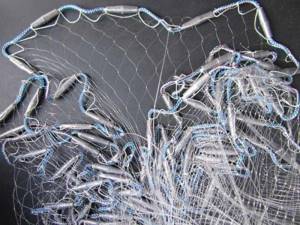
A net with an elastic band is designed on the principle of a donkey with a rubber shock absorber, only here, instead of a dozen hooks, there is a net.
It is structured as follows:
- a pole for securing the gear on the shore (a regular stick can be used instead);
- fishing line connecting the mesh and the pole;
- network (up to 7 m);
- the top edge is equipped with a floating cord;
- the lower edge is threaded with weights (weight cord);
- cargo (stone or brick);
- rubber thread (connects the upper edge of the mesh and the load).
Sometimes a signal bell is tied to the fishing line, notifying the fisherman about a bite. The use of a bell is justified when it comes to catching large fish.
If a large perch gets caught in the net, it will roll up its web with its power and no one else will get caught there. With the use of a bell, a fisherman in such a situation will be able to remove the catch and cast the tackle again.
Throwing a net goes like this:
- A fisherman throws a load into the river.
- The load pulls along a net with a float and cargo line.
- The fishing line and shock absorber, fastened with carabiners, are separated and attached to loops located at the ends of the float cord.
- The weight of the carabiners is offset by two foam floats, which, in addition, help the net keep its rectangular shape.
The height of the device reaches one and a half meters, length – 7 m.
Which fishing line to choose for a baitcasting reel video
You can watch the video “Fishing Investigations” with the Shcherbakov brothers online in good quality on our website which fishing line to choose for a multiplier reel for long-distance casting: fluorocarbon or braided fishing line. Enjoy watching!
We suggest you read: Responsibility for fishing with nets
Watch in this issue - the Shcherbakov brothers decided to check - which fishing line is better for long-distance casting? If you have a baitcasting reel, which line should you choose for long casting: braided or fluorocarbon?
Features of operation
Fishing with a fishing line requires knowledge of the body of water and its inhabitants.
Fishing with such nets using complementary foods, for example, a mixture will be especially successful:
- silt;
- sand;
- clay;
- pearl barley;
- cake;
- garlic, etc.
Then, even in the absence of a float bite, you will get several small trophies.
Throw it in after clearing the bottom.
It is necessary to correctly calculate the weight of the load so as not to accidentally tear the rubber when removing the catch.
Features of fishing using a net
As a rule, a track tackle, a video of the use of which can be watched on the Internet for a more complete understanding of what is at stake, is placed somewhere along the way to the main fishing spot, but can also be used as the main type of fishing.
One of the most effective ways is when there are two people in the boat. In such conditions, one rows while the other casts the net. If there is only one fisherman, the spoon can be thrown out of the boat while moving and lowered by approximately 40-50 meters of fishing line.
You should always strive to ensure that the path is as far away from the boat as possible, because a boat, and especially if a boat with an electric motor, scares away the fish. If we consider the situation in terms of numbers, then the height of the net should not exceed one and a half meters, and the length when casting from the shore will be approximately seven meters.
“Track” fishing is suitable for you if you have thoroughly studied the place for fishing, in particular a body of water. It is worth considering that the weight of the thrown load with bait must be calculated in such a way that when you pull it out, the rubber does not break.
Ideally, it is better to tie a small strong piece of fishing line between the rubber band and the load, which would protrude one and a half to two times the size of the rubber shock absorber. However, this may not always help.
Even though you are using a net and not a fishing rod, you also need to place a warning bell on it. Otherwise, the only fish that comes along will get caught in the net when other fish swim by.
A path equipped with fishing tackle is perfect for small bodies of water located near cities. The net will not prevent you from fishing and fishing at the same time, for example. For successful fishing, you need to pay attention not only to the quality of the equipment, but also to have a good boat.
Basically, advanced fishermen prefer inflatable boats, in particular, products from Ufa. For example, quite interesting models “Aigul” and “Ufimka”. These boats delight the buyer with their maneuverability, long service life, speed and comfortable wooden seats.
Depending on where exactly you place the net, your catch depends. For example, if the bottom is not viscous, then you can put a path near the shore - for this you don’t even need to swim somewhere. This is a very good way to set up a net during the active hunting season for predators.
Using boats gives you more room to maneuver. A good catch will be ensured by a net placed in places where the depth of the bottom changes sharply - a kind of cliff, only under water. In such places, pike perch and perch are often caught in the net.
After each fishing trip, the net, like any tool, must be carefully inspected for holes, timely repairs made as necessary, and cleaned of algae and other debris. The positive aspects of elastic compared to other bottom fishing rods:
- In case you are catching a large fish, it is unlikely that the line will break, since the elastic band is shock-absorbing;
- High sensitivity;
- You can catch any fish with this type of bottom fishing rod;
- The process of re-planting bait is greatly facilitated due to the fact that the hooks do not lie on the ground, but hang on a fishing line;
- The sinker does not cling to any obstacles such as stones and grass, which makes landing fish more convenient.
How to make
You can make an elastic band with your own hands from simple and inexpensive materials that can be easily purchased at any fishing or hardware store.
This gear has the following device:
- main line;
- rubber shock absorber;
- leashes with hooks;
- sinker tied on a nylon cord (allowed without it);
- reel or reel for storing and winding fishing line;
- bite alarm (bell).
So, monofilament with a diameter of 0.40–0.50 mm is used as the main fishing line. When catching small fish, such as crucian carp or perch, you can take a monofilament line 0.20–0.25 mm in diameter. The length of the working cord depends on the fishing range, but it is advisable to have several tens of meters in reserve.
Leashes are also knitted from monofilament. Only their diameter should be slightly smaller than the main line. This is done so that in the event of a possible snag, only this element breaks off, and the tackle itself survives.
The length of the leashes varies from 10 cm to a meter. It all depends on the mood of the fish, the bait used and the actual fishing conditions (spit or hole, with or without current). The hook is tied to the intended bait.
The elastic band is selected to have a round cross-section. The length of the shock absorber ranges from 5 to 20 meters, depending on the fishing distance. It usually stretches four to five times, which should be taken into account when choosing its length.
For loading, either a brick or stone, or a lead sinker is used. The weight of the sinker is determined by the presence of current, the hardness of the bottom and the fishing distance. A meter of thick fishing line or nylon cord is tied to the load, which is then connected to an elastic band.
A bell is usually used as a bite alarm. In “field” conditions, you can use an ordinary twig. If the donka is stationary for several days, and the fisherman comes to check it only periodically, then it would be correct to do without this element, so as not to attract unnecessary attention to the unattended gear.
To wind the tackle, you can use homemade wooden or foam reels, or you can buy factory ones made of plastic. Less commonly used is an inertial reel attached to a short fishing rod.
When fishing at long distances with a large load, when it is impossible to cast the tackle from the shore and you have to use a boat, it is also necessary to equip the elastic with a foam plastic float. It is tied to a load with a rope or thick fishing line. Such a buoy shows the location of the sinker so that you don’t have to look for it at the end of the fishing trip.
How to tie an elastic band with fishing line
There are several ways to connect the main line with an elastic band:
- loop in loop;
- tie the fishing line and shock absorber to the swivel;
- using fishing knots;
- using a rubber tube.
The last method is very original and is somewhat similar to a “loop-to-loop” connection:
- A silicone tube up to five cm long is placed on the end of the elastic band, and a loop is tied so that the tube is inside the loop.
- Then the main fishing line is threaded into the tube and a loop is also knitted.
That's it, the connection is ready. It is very simple, reliable and can withstand loads of up to a kilogram.
Which cargo is better
Of course, it is advisable to have a lead sinker. Its shape should allow the equipment to be securely fixed at one point. Most often, ring-shaped weights with notches along the perimeter are used. This type is great for currents and hard bottoms.
Other models can be used in calm waters. The main thing is that when removing the gear from the water, the elastic band cannot move this anchor from its place. If lead is not at hand, then ordinary brick or stone will do.
About leashes
When catching peaceful fish, leashes are made from monofilament. Their length is selected based on the mood of the fish and the presence of current. In passive fishing they are usually longer than in active fishing. They are made especially long when catching pelagic fish: sabrefish, blue bream and other species.
It is advisable to catch predatory fish with metal leashes. This way you can avoid cutting the bait. To do this, use thick monofilament fishing line, folded in half, or fluorocarbon.
Nozzles
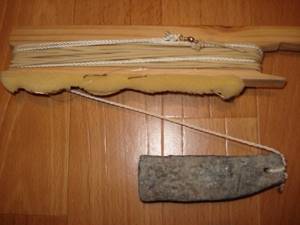
The range of baits used when fishing with rubber bands is very large. Both bait and plant baits are used, and live bait is used. The most popular of them are the following:
- worm;
- bloodworm;
- live bait;
- canned corn;
- maggot;
- boiled potatoes;
- canned peas;
- dough;
- caddisfly and larvae of other semi-aquatic insects;
- crayfish meat;
- frog;
- bread.
And this is not all the bait. In fact, you can hook any bait or attachment used in the fishing area by local fishermen onto a rubber donkey hook.
